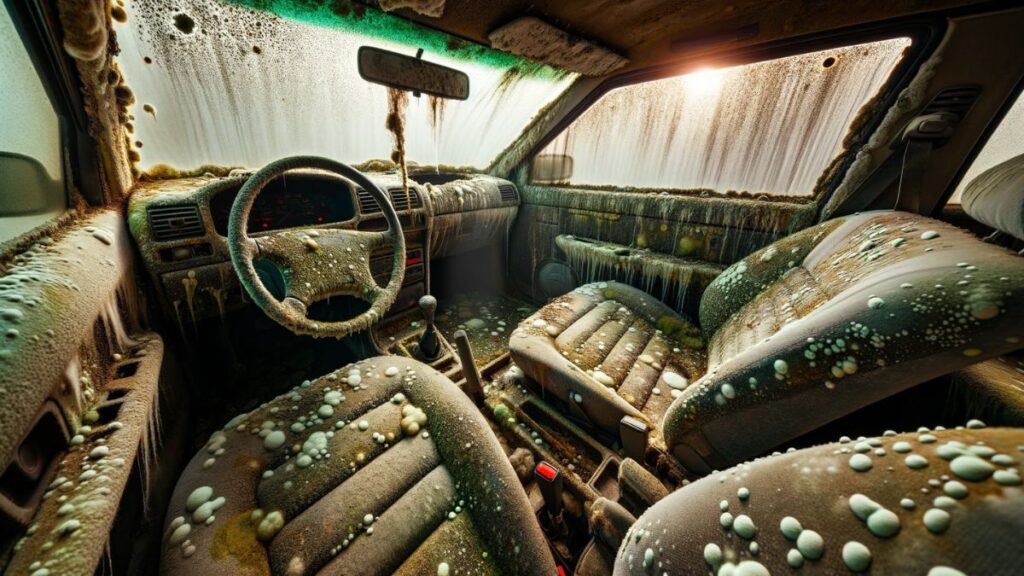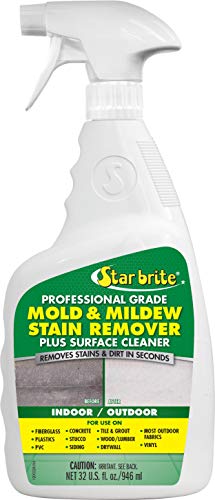How To Clean Mold Out Of a Car
Car Detailing Planet is a part of Amazon Associates. As an Amazon Associate, we earn from qualifying purchases. Read our Affiliate Disclosure to learn more.

I hope you won’t ever have to deal with mold inside your car, but if you do, you should follow this guide on cleaning mold out of a car. I always follow these steps, and so far, I’ve always been able to remove mold from any vehicle and get an immaculate result.
How To Clean Mold Out of a Car?
Here are all the steps I follow when dealing with a moldy car interior.
Step 1: Dry Out the Car
- Before any cleaning begins, it’s crucial to reduce the moisture level inside the car, as mold thrives in damp environments.
- Open all windows and doors.
- Use a fan or dehumidifier and, if possible, park the car in direct sunlight.
Step 2: Vacuum the Interior
- Use a vacuum cleaner equipped with a HEPA filter to remove loose mold spores and debris from upholstery, carpets, and other affected areas.
Step 3: Prepare the Vinegar Cleaning Solution
- In a spray bottle, mix 4 parts white vinegar with 1 part water.
- Test the solution on a small, hidden area to ensure it doesn’t harm the car’s interior surfaces.
Step 4: Apply Vinegar Solution to Mold
- Spray the solution onto areas affected by mold. You can use it on all interior surfaces, such as seats, carpets, dashboards, doors, etc.
- Allow it to sit for 10-15 minutes to break down the mold spores.
Step 5: Scrub and Wipe
- Use a soft cloth or sponge to gently scrub the treated areas, removing the mold.
- After scrubbing, use a clean, damp cloth to wipe off the mold and any remaining vinegar solution.
Step 6: Apply Baking Soda
- For additional moisture and odor absorption, sprinkle baking soda on the treated areas.
- Let it sit for a few hours or overnight, then vacuum it up.
Step 7: Final Drying
- Ensure the car’s interior is completely dry to prevent mold from returning.
- Use a fan or dehumidifier and leave windows open if weather permits.
3 Great Mold Removers You Can Use As Well
Besides mixing vinegar with water and soda, here are three more options you can use.
1. Hydrogen Peroxide

- Mix 1 part hydrogen peroxide (3% concentration) with 2 parts water in a spray bottle.
- Spray the solution onto the mold-infested areas.
- Allow it to sit for 10-15 minutes to kill the mold.
- Scrub the surfaces with a clean cloth or sponge.
- Wipe the area to remove any residue.
2. Tea Tree Oil

All of us all well aware of the antifungal properties of Tea tree oil. Tea tree oil is an effective solution for mold removal.
- Mix 2-3 teaspoons of oil with 2 cups of water in a spray bottle.
- Shake the bottle well to ensure proper mixing.
- Spray the tea tree oil solution onto the affected areas and let it sit for a few hours.
- Wipe the interior surfaces with a soft damp cloth to remove any remaining mold and tea tree oil residue.
3. Commercial Mold Removers
There are several commercial mold removers available on the market. I suggest using Star Brite Professional Mold & Mildew Stain Remover (check above).
Always ensure good ventilation when using commercial products and use them according to the manufacturer’s recommendations.
Safety Precautions When Cleaning
Before cleaning, ensure proper ventilation by opening the car windows or working in a well-ventilated area.
Wear a mask, protective glove, and safety goggles to avoid potential health risks from exposure to fungi spores. Here’s my guide on protective gear for car detailers.
If the mold infestation is severe or covers a large area, it’s advisable to seek professional help to ensure proper and thorough removal.
Importance of Cleaning Mold From Your Car ASAP

Mold presence in your vehicle is not just a cosmetic issue; it poses serious health risks and can lead to extensive damage to your car’s interior. Here’s why prompt action is crucial:
- Health Hazards
- Mold, much like shotgun fungus, can severely impact health, particularly for those with respiratory issues, allergies, or compromised immune systems.
- Exposure to mold spores may result in symptoms like coughing, sneezing, eye and throat irritation and potentially lead to respiratory infections.
- Unpleasant Odors
- Mold growth typically brings a musty, disagreeable odor, which is more pronounced in confined spaces such as cars.
- Damage to Car Interior
- Mold can leave lasting stains and discoloration on upholstery, carpets, and other surfaces.
- It can weaken fabrics and materials, hastening their deterioration, which often results in expensive repairs.
- Structural Integrity Risks
- If mold spreads to essential components like the dashboard or seats, it can compromise the structural integrity of these parts.
- Resale Value Impact
- A mold-infested car is less appealing to potential buyers and is often seen as a sign of neglect and possible hidden issues.
Therefore, treating mold in your car should be a priority to protect both your health and your vehicle’s value and condition.
What Causes Mold In Cars?
Understanding the primary causes of mold in cars can help prevent and address this issue effectively:
- Moisture Accumulation
- Moisture inside the car, often from excessive humidity, water leaks, or wet items like clothing and carpets, is the main cause of mold growth.
- Spilled liquids and condensation, resulting from temperature differences between the car’s interior and exterior, also contribute to moisture buildup.
- Inadequate Ventilation
- Poor airflow within the car traps moisture, creating a humid environment ideal for mold. This can be due to blocked air vents, a malfunctioning air conditioning system, or frequent use of the air recirculation setting.
- Neglecting Spills and Leaks
- Ignoring or delaying the cleanup of spills and leaks in the car can lead to mold formation, as these provide the necessary moisture for mold spores to flourish.
Proactive measures, like regular maintenance and prompt response to moisture issues, can significantly reduce the risk of mold in your car.
How to Prevent Future Mold Growth?
After cleaning the mold from your car, you should take safety measures to prevent the mold from growing inside your car again.
Here are the most important tips you should follow to prevent mold growth in cars:
- Dry Wet Items Immediately: If anything wet is left in the car, remove and dry it promptly.
- Clean Spills Quickly: Wipe up any liquid spills as soon as they happen.
- Use Moisture Absorbers: Place silica gel packs or activated charcoal in the car to absorb excess moisture.
- Regular Ventilation: Frequently air out your car by opening windows or using the air conditioning system.
- Maintain Air Conditioning: Ensure the air conditioning system is working correctly to control humidity levels.
- Check for Leaks: Routinely inspect for and fix any leaks in the car’s roof, doors, or windows.
- Keep Air Vents Clean: Ensure air vents are unobstructed for proper airflow.
- Frequent Vacuuming: Regularly vacuum the interior to remove potential mold spores.
- Professional Cleaning: Consider deep cleaning your car’s interior occasionally, especially in humid climates.
FAQ
Yes, baking soda can somewhat help kill mold due to its alkaline properties. However, it may not be as effective as specialized mold cleaners or professional mold remediation methods.
Vinegar is generally safe for cleaning car interiors. It can be used to remove stains, odors, and mildew. However, it’s recommended first to test it on a small, inconspicuous area to ensure it doesn’t cause discoloration or damage.
A common homemade mold remover is a mixture of white vinegar and water. Other options include a solution of hydrogen peroxide and water or a paste from baking soda and water.
Lemons contain citric acid, which has some antimicrobial properties. However, lemon alone may not be strong enough to remove mold completely. It can be used as a part of a cleaning solution, but it’s advisable to use specialized mold cleaners for effective mold removal.

